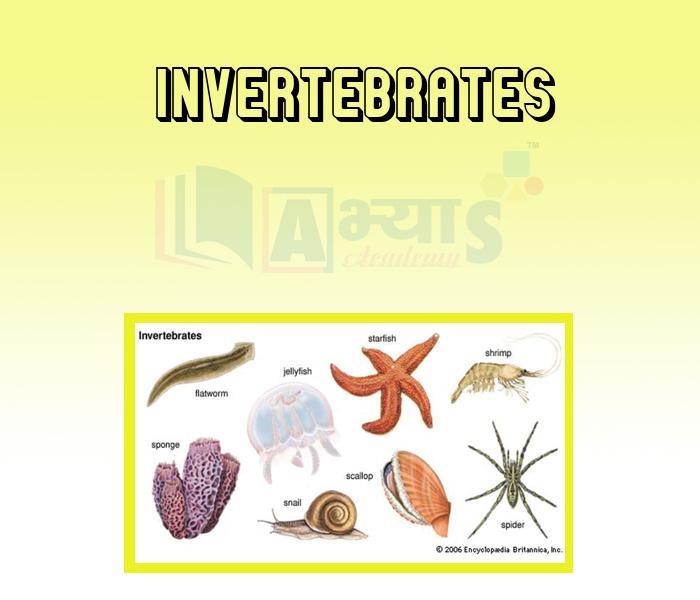Invertebrates











Invertebrates
Invertebrates: Invertebrates are animals lacking a backbone. Invertebrates are by far the most numerous animals on the earth. Nearly 2 million species have been identified to date. These 2 million species make up about 98 percent of all the animals identified in the entire animal kingdom. Some scientists believe that the true number of invertebrate species may be as high as 100 million and that the work of identifying and classifying invertebrate life has only just begun.
Invertebrates live in a vast range of habitats, from forests and deserts to caves and seabed mud. In oceans and lakes they form part of the plankton - an immense array of miniature living organisms that drift in the surface currents. Invertebrates are also found in the soil beneath our feet and in the air above our heads. Some are powerful fliers, using wings to propel themselves, but others, particularly the smallest invertebrates, float on the slightest breeze. These tiny invertebrates form clouds of aerial plankton that drift unseen through the skies. Although the majority of invertebrates are small, a few reach impressive sizes.
Physical Characteristics: Due to their numbers and variety, invertebrates share only a single trait: the absence of a backbone. Many invertebrates have no hard body parts at all. These soft-bodied invertebrates, which include earthworms, keep their shape by maintaining an internal pressure, similar to the air pressure within an inflated balloon. However, having a soft body has disadvantages, one of which is that it leaves animals vulnerable to attack from predators.
To detend against predators, other invertebrates have evolved exoskeletons, hard outer coverings such as he shells found in clams and molluscs, and the body cases that surround adult insects. Besides protecting the animal, these exoskeletons also provide anchorage for muscles. Arthropods, animals with a hard, outer skeleton and a jointed body and limbs, make up the single largest group of invertebrates. Arthropods include insects, crustaceans, and arachnids, such as spiders and ticks.
Invertebrates differ from each other internally in a wide variety of ways. Some have respiratory organs,circulatory systems, and excretory organs for getting rid of waste. The simplest invertebrates survive with fews or no specialised organs at all. These animals absorb what they need from their surroundings-a way of life that works only in watery habitats and only with small animals.
Students / Parents Reviews [10]
It has a great methodology. Students here can get analysis to their test quickly.We can learn easily through PPTs and the testing methods are good. We know that where we have to practice

Barkha Arora
10thOne of the best institutes to develope a child interest in studies.Provides SST and English knowledge also unlike other institutes. Teachers are co operative and friendly online tests andPPT develope practical knowledge also.

Aman Kumar Shrivastava
10thIt was a good experience with Abhyas Academy. I even faced problems in starting but slowly and steadily overcomed. Especially reasoning classes helped me a lot.

Cheshta
10thA marvelous experience with Abhyas. I am glad to share that my ward has achieved more than enough at the Ambala ABHYAS centre. Years have passed on and more and more he has gained. May the centre flourish and develop day by day by the grace of God.

Archit Segal
7thMy experience with Abhyas is very good. I have learnt many things here like vedic maths and reasoning also. Teachers here first take our doubts and then there are assignments to verify our weak points.

Shivam Rana
7thI have spent a wonderful time in Abhyas academy. It has made my reasoning more apt, English more stronger and Maths an interesting subject for me. It has given me a habbit of self studying

Yatharthi Sharma
10thAbhyas Methodology is very good. It is based on according to student and each child manages accordingly to its properly. Methodology has improved the abilities of students to shine them in future.

Manish Kumar
10thAbout Abhyas metholodology the teachers are very nice and hardworking toward students.The Centre Head Mrs Anu Sethi is also a brilliant teacher.Abhyas has taught me how to overcome problems and has always taken my doubts and suppoeted me.

Shreya Shrivastava
8thIt was good as the experience because as we had come here we had been improved in a such envirnment created here.Extra is taught which is beneficial for future.

Eshan Arora
8thMy experience was very good with Abhyas academy. I am studying here from 6th class and I am satisfied by its results in my life. I improved a lot here ahead of school syllabus.
